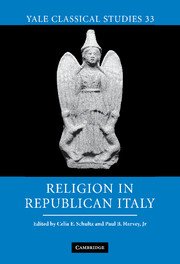Book contents
- Frontmatter
- Contents
- List of illustrations
- List of contributors
- Acknowledgments
- List of abbreviations
- Introduction
- Chapter 1 Reconsidering “religious Romanization”
- Chapter 2 In search of the Etruscan priestess: a re-examination of the hatrencu
- Chapter 3 Etruscan religion at the watershed: before and after the fourth century bce
- Chapter 4 Religious locales in the territory of Minturnae: aspects of Romanization
- Chapter 5 Religion and memory at Pisaurum
- Chapter 6 Inventing the sortilegus: lot divination and cultural identity in Italy, Rome, and the provinces
- Chapter 7 Hot, cold, or smelly: the power of sacred water in Roman religion, 400–100 bce
- Chapter 8 Religion and politics: did the Romans scruple about the placement of their temples?
- Chapter 9 Juno Sospita and Roman insecurity in the Social War
- Chapter 10 Beyond Rome and Latium: Roman religion in the age of Augustus
- Bibliography
- Index
Chapter 9 - Juno Sospita and Roman insecurity in the Social War
Published online by Cambridge University Press: 08 January 2010
- Frontmatter
- Contents
- List of illustrations
- List of contributors
- Acknowledgments
- List of abbreviations
- Introduction
- Chapter 1 Reconsidering “religious Romanization”
- Chapter 2 In search of the Etruscan priestess: a re-examination of the hatrencu
- Chapter 3 Etruscan religion at the watershed: before and after the fourth century bce
- Chapter 4 Religious locales in the territory of Minturnae: aspects of Romanization
- Chapter 5 Religion and memory at Pisaurum
- Chapter 6 Inventing the sortilegus: lot divination and cultural identity in Italy, Rome, and the provinces
- Chapter 7 Hot, cold, or smelly: the power of sacred water in Roman religion, 400–100 bce
- Chapter 8 Religion and politics: did the Romans scruple about the placement of their temples?
- Chapter 9 Juno Sospita and Roman insecurity in the Social War
- Chapter 10 Beyond Rome and Latium: Roman religion in the age of Augustus
- Bibliography
- Index
Summary
In 90 bce, the Senate of Rome, stirred to action by a report of a vision seen by Caecilia Metella, a member of one of the most prominent families in Rome, ordered one of that year's consuls to oversee the refurbishment of the Temple of Juno Sospita. Although this incident occurred against the backdrop of the Social War, it is rarely treated in discussions of that conflict. This is no great surprise since, unlike the prominence accorded religious events in some treatments of the Hannibalic War, divine matters in general are outside the scope of treatments of the Social War – in all likelihood a reflection of the absence of religious themes from Appian, B. Civ. i.150–231, our most important ancient source on the war. Furthermore, the popular notion that Juno Sospita was concerned primarily with feminine fertility has obscured the relationship between the refurbishment of her temple and the contemporary military conflict. The present study considers Caecilia's dream within the context of the Social War and aims to recover the implications of the Senate's reaction to it. In sum, this episode was a product of the inextricable relationship between politics and religion in Republican Rome; more specifically, it is indicative of the Romans' insecurity about their ability to maintain control in Italy without divine support. By coming forward with her dream, Caecilia performed a great service to the res publica, and it appears that her family chose to call attention to this episode many years after the fact.
- Type
- Chapter
- Information
- Religion in Republican Italy , pp. 207 - 227Publisher: Cambridge University PressPrint publication year: 2006
- 6
- Cited by



